 Do you know what a Cloud Solution Provider (CSP) is?
Do you know what a Cloud Solution Provider (CSP) is?
CSP is a term that has gained popularity in the past few years, thanks to the rise of Cloud Computing.
As the former owner of an IT Managed Service Provider (MSP) business, I am used to hearing the question “What is a Managed Service Provider?”
Therefore, I wrote about my definition of an MSP.
But fast-forward to today, and I’m just as frequently being asked the question “What is a CSP?”
Many businesses are looking for alternatives to onsite data storage and have begun exploring cloud solutions instead.
But there is a huge variety of options in the cloud marketplace. How does an organisation know which platform(s) to choose?
This is where a Cloud Solution Provider (CSP) can be of help.
What is a Cloud Solution Provider?
A CSP is an IT company which provides and manages cloud solutions for its clients.
These clients might be small and medium sized businesses (SMBs), or multinational organisations.
The cloud solution the CSP provides will depend on the needs of each client, and will be tailored accordingly.
There are many specialist CSPs, who offer specific solutions, such as productivity, Customer Relationship Management (CRM), Enterprise Resource Management (ERP) and Unified Communications (UC).
However, in this article, I’m going to share my insight into a typical CSP who works with small businesses.
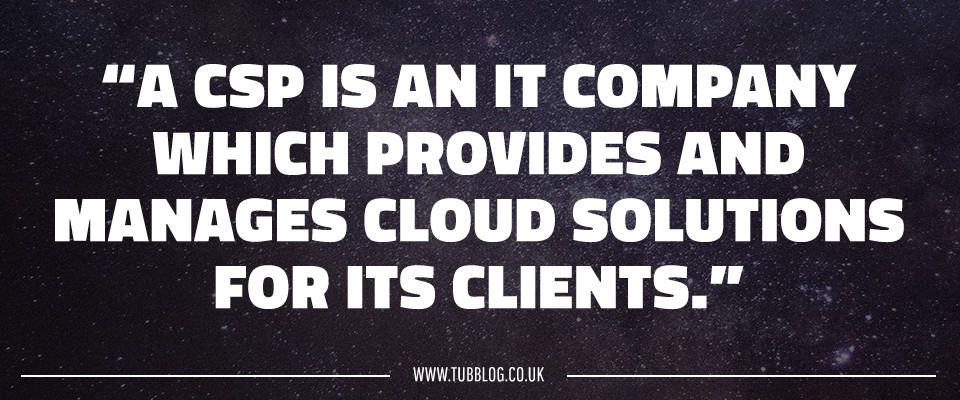
Microsoft Cloud Solution Providers
One of the earliest references to Cloud Solution Providers (CSPs) was from Microsoft.
The official Microsoft cloud programme is called Microsoft CSP.
As a result, a lot of IT providers who resell Microsoft products have started referring to themselves as CSP’s.
However, being a CSP can be much more than just reselling Microsoft solutions.
Which Solutions Does a CSP Offer?
 In terms of the solutions, a CSP may offer its clients:-
In terms of the solutions, a CSP may offer its clients:-
- Third-party cloud-based suites or stacks, such as Microsoft 365, Google Workspace or 1Stack Cloud. These stacks/suites are managed and updated by the provider, and are a direct replacement for hosting your own on-site email server.
- Cloud-based infrastructure, such as Microsoft Azure, Amazon Web Services, Vultr, Digital Ocean or Linode. This is often known as an Infrastructure-as-a-Service (IaaS). IaaS, is intended to replace onsite data centres.
- Application solutions, such as Salesforce, Xero or Atlassian. This is often known as Software as a Service (SaaS). The main benefit of SaaS is that the business doesn’t have to purchase software licenses as a one off-fee – the provider offers access and hosting for a monthly or annual fee.
- Cloud-based storage solutions, such as Dropbox, Amazon S3 or Linode Block Storage. As well as peer-to-peer storage, which replaces on-site file servers, many flavours of these cloud-based storage solutions can be used for Backup & Disaster Recovery (BDR). The advantage is that your data is securely stored off-site, offering global accessibility and reducing maintenance costs.
Therefore, in summary, if the data is stored in the cloud then you have a potential solution a CSP could offer to clients.
In reality, a good CSP offers a range of solutions to their clients — aiming to become a “one-stop-shop” for cloud solutions.
It is also worth noting that while a good CSP offers strong cloud solutions to their clients, a great CSP adds additional value.
This additional value comes as a result of the consultative guidance, support and strategy which matches up the client needs to the right piece of cloud technology.
In short, a CSP doesn’t just resell solutions — they wrap their own value around them.
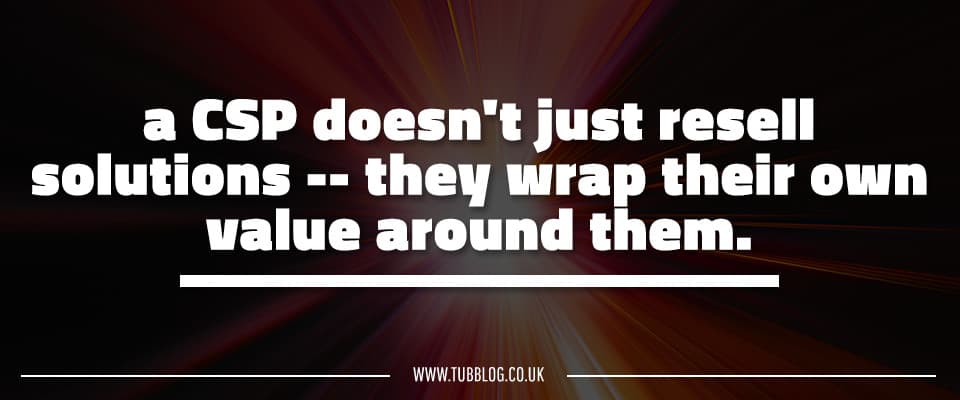
Public vs Private Cloud Solutions
 In the above examples, I’ve mentioned a number of 3rd party cloud platform providers.
In the above examples, I’ve mentioned a number of 3rd party cloud platform providers.
Typically, at the SMB space, most IT businesses who have become CSPs follow this model of reselling these solutions to their clients.
These solutions are known as Public Cloud solutions.
The benefits to the CSP of this model are that the heavy lifting of building the cloud-based infrastructure has already been done for them.
A CSP following this model doesn’t have to worry about finding a data centre, buying equipment, installing and managing it.
However, some CSPs do choose to build their own infrastructure.
This is known as building a Private Cloud solution.
This is a huge investment, and requires ongoing monitoring and maintenance.
It is an investment that is typically beyond the scope of the audience of this web-site — the owners of SMB-sized IT businesses.
Therefore, for the sake of this article, I’ll refer to CSPs as the type of IT companies who resell and manage these 3rd party public cloud offerings.
What Does a CSP do for a Client?
For a small business looking to find help in moving their data to the cloud (or indeed, managing an existing cloud infrastructure), a CSP will be a great partner.
An IT Managed Service Provider (MSP) might help a client choose their on-site infrastructure, and then manage it.
In a similar vein, a CSP helps a client choose the right cloud solution and then manages it for them.
For the client, the advantage of working with a CSP is the reassurance of having your data managed by an expert partner who will give support when needed.
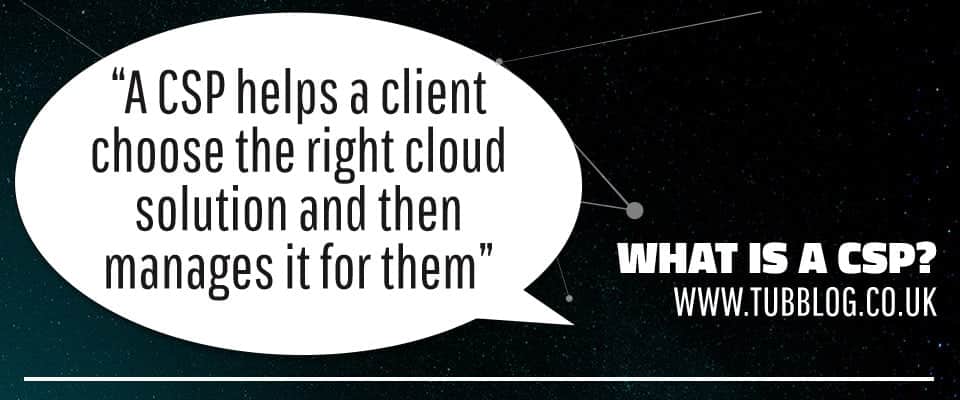
Why Would a Client Work With a CSP Rather Than go Direct?
 Many 3rd party cloud platform providers — such as Google and Microsoft — offer their tools direct to buyers, in additional to via CSP resellers.
Many 3rd party cloud platform providers — such as Google and Microsoft — offer their tools direct to buyers, in additional to via CSP resellers.
This means that if a small business wanted to buy Microsoft 365, they can purchase it directly from Microsoft.
As a result of going direct, if the business needs assistance setting up the cloud solution, or ongoing support, they need to go to the provider.
The downside of this model is that while the likes of Google and Microsoft do offer support for direct clients — this support can be a frustrating experience.
In reality, the client is unlikely to have the technical skills to be able to effectively talk to a support team about their issues.
As a result, the advantage of working with a CSP is that you have an expert who can manage the platform for you.
If a client has any problems with their cloud infrastructure, the CSP will manage those issues for them.
For the vast majority of organisations who don’t have an internal IT resource, partnering with a CSP is the most sensible move.
Clients Safety Comes First with CSPs
Another benefit for an SMB in working with a CSP, rather than going direct, is security.
The world of cloud solutions changes at a rapid pace.
New features emerge, and so do new risks.
With cybersecurity being high on most organisations agenda nowadays, working with a CSP can help mitigate those risks.
A good CSP will specialise in cloud solutions and be aware of the latest changes and new challenges in the threat landscape.
Therefore, a SMB who works with a CSP will not only be ensured of getting the best use of the latest features, but that their data is kept safe too.
As a result, clients can actually save money by working with a CSP by avoiding paying for multiple cloud solutions that, in reality, do the same thing.
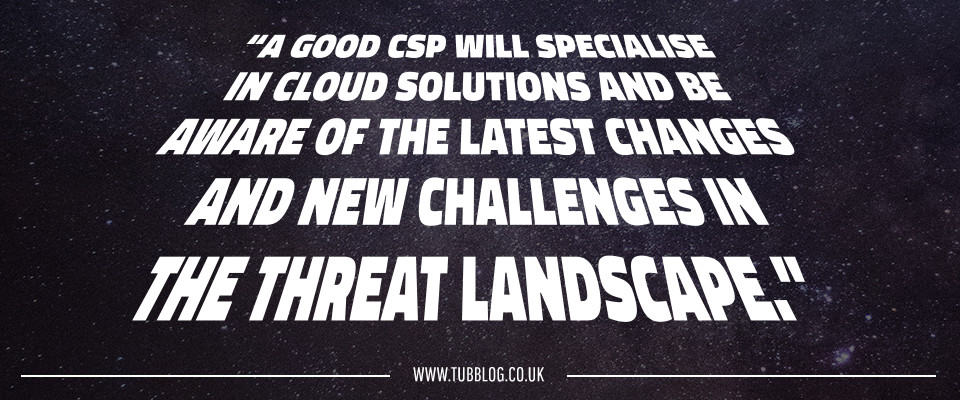
On-Site Vs Cloud Solutions
 If you’re an existing Managed Service Provider (MSP) then you likely have a number of clients with on-site infrastructure.
If you’re an existing Managed Service Provider (MSP) then you likely have a number of clients with on-site infrastructure.
As a result, you are paid to monitor and manage this infrastructure.
So the question is — why would you move that infrastructure to the Cloud?
As an MSP, won’t you lose income if you remove the clients on-site infrastructure?
What will be left for an MSP to do in the new cloud world?
If you move from the MSP to the CSP model, then you will have to find a different way to charge for the value of your services.
The value a CSP typically offers comes via the service, support and guidance they offer their clients on an ongoing basis.
When it comes down to it, the concept of being a CSP is much like the concept of being an MSP.
A good MSP doesn’t charge for their time, they charge for the skill and expertise the bring to the relationship.
For instance, while it may only take two minutes to change a setting in a cloud solution portal, knowing where and how to spend those two minutes can save a client hours or even days of frustration and delays.
As a result, CSPs need to focus on a value mindset and not a traditional cost+ mindset.
While this concept isn’t too different to the traditional Managed Service model employed with on-site hardware, many IT businesses struggle to adapt to this concept.
Consequently, while many MSPs are resisting the change, the reality is that clients see the benefits of moving to the cloud.
The Benefits of Cloud Computing for Clients
 Traditional on-site solutions are typically purchased as a capital expenditure (CAPEX).
Traditional on-site solutions are typically purchased as a capital expenditure (CAPEX).
As a result, your clients need to make upfront investments in hardware and software.
However, Cloud solutions are typically paid for on a monthly or annual basis. These payments are categorised as an operating expenditure (OPEX).
This means that there is rarely a big upfront investment for your client.
Traditionally, software was purchased as a license and owned by a client.
However, in the modern day, most businesses prefer the flexibility of cloud solutions for scalability.
If your client employs more staff, they can increase their monthly license count.
But, if your client downsizes, then they can reduce their cloud license count. As a result, your client hasn’t purchased licenses which they no longer need.
While there is still a place for on-site solutions, the majority of businesses are looking to the cloud to increase their flexibility and reduce their capital expenditure.
MSPs need to be aware of this shift in mindset and change their offering accordingly.
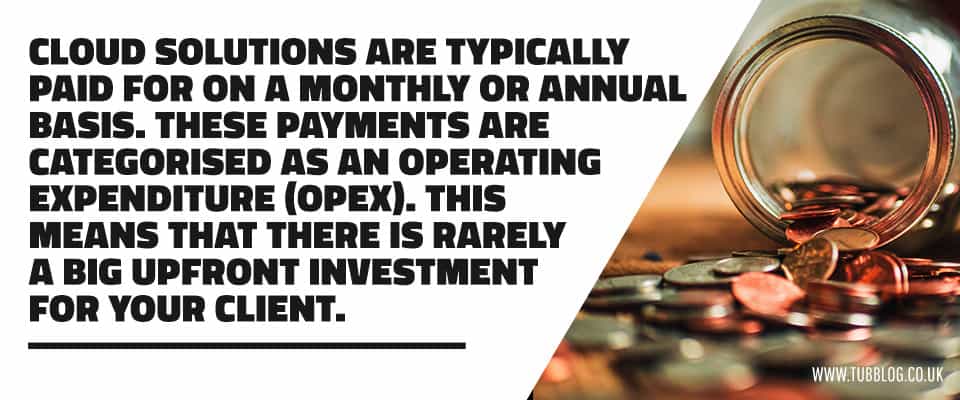
Moving Your MSP to the Cloud Model
 If you’re an MSP, then Cloud solutions will almost certainly be a good addition to your existing portfolio.
If you’re an MSP, then Cloud solutions will almost certainly be a good addition to your existing portfolio.
Being an MSP and being a CSP are not mutually incompatible.
As a result, many MSPs offer their clients a choice of on-site infrastructure or cloud solutions.
In fact, the vast majority of MSPs that I know offer a hybrid mixture of cloud solutions and on-site infrastructure.
Then there are some CSPs, such as UK-based Cloud Nexus, who offer a pure Microsoft cloud-based solution to their clients.
You can check out my interview with Scott Riley, owner of Cloud Nexus, and his thoughts on How to Build A Successful Cloud Solution Provider Business.
Other MSPs, such as UK-based Abussi, have moved their existing MSP clients into a CSP model.
These CSPs don’t just sell 3rd party solutions to clients and make a small markup on resale.
Instead, much like the Managed Service model, these CSPs generate revenue revenue based on charging for the consultancy and ongoing support services they offer.
The Cloud Solution Provider model is not too different to the Managed Service Provider model.
In both models, your business is paid for the expertise you can provide, and the peace of mind you offer the client in managing their solutions.
Where Does a CSP Buy its Solutions From?
In the traditional world, an MSP that sold hardware and software would buy their kit from a distributor.
These distributors provided a conduit between vendors and MSPs.
If we fast-forward to the modern day, a similar arrangement can be found for Cloud Solution Providers.
There are a range of cloud marketplace providers available.
These cloud marketplace providers (sometimes referred to as Cloud Service Providers, not to be confused with the subject of this article – Cloud Solution Providers) will offer a variety of cloud solutions to CSPs for resale to their clients.
Some of the most notable cloud marketplace providers in the UK include:-
- Giacom
- Pax8
- QBS:MSP (formerly known as Zedsphere)
- Zen Software
Other providers, such as 1Stack Cloud or Linode, offer a alternative to the big direct players such as Amazon, Google or Microsoft.
As a CSP, when it comes to finding a cloud marketplace provider (or distributor) then I’d encourage you to look around.
Ask for recommendations in your local peer group, or check out reviews in online communities such as The Tech Tribe.
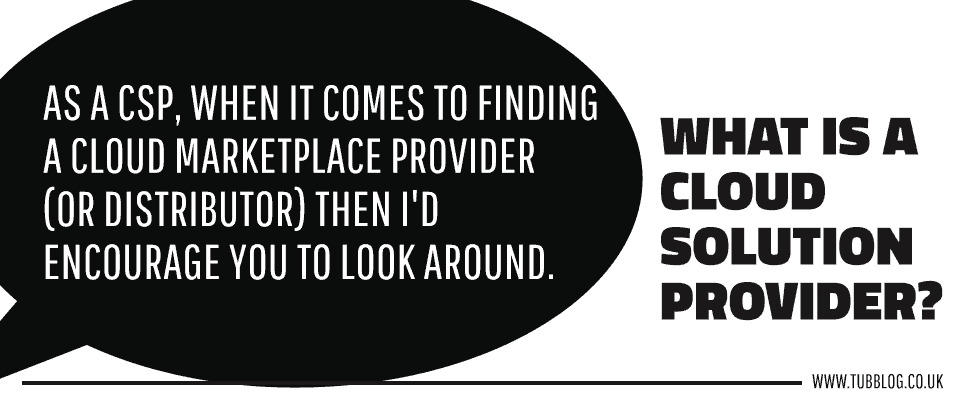
How to Undertake Due Diligence for Cloud Solutions
 When your Cloud Solution Provider business is choosing a cloud platform to offer to your clients, always make sure to ask your distributor for details on:-
When your Cloud Solution Provider business is choosing a cloud platform to offer to your clients, always make sure to ask your distributor for details on:-
- Testimonials from existing CSP clients
- Service Level Agreements (SLAs)
- Reporting facilities
- Integration with CSP tools such as your Professional Services Automation (PSA) tool.
- Understanding where your clients data is stored (for GDPR and other compliance reasons)
Things to look out for in cloud distibutor might include:-
- The ease of using a provisioning portal
- Clear pricing of products
- The potential margin on reselling products
- Simple monthly reconciliation on per-client billing
- Automated provision of cloud solutions
- Client Self-Service (coupled with a strong approval process for the CSP)
Most importantly, check how the provider will be keeping your data secure.
Ultimately, your responsibility as a CSP is to keep your clients data safe.
Make sure you take that responsibility seriously.
If you’re intrigued to know more about your legal responsibilities as a CSP, then read my article on The Top 5 Legal Questions Asked by MSPs about Cloud Computing.
Conclusion
If we were to summarise what I’ve written above in one sentence, it would be this.
Cloud Solution Providers don’t simply sell cloud products, they sell their expertise.
Many businesses and organisations of all sizes are looking to move their IT infrastructure from on-site to the cloud.
Cloud computing offers organisations more flexibility and scalability over their IT, and moves IT costs from the Capital Expenditure (CAPEX) accounting column to the Operating Expenditure (OPEX) column.
As a result, many IT businesses are adapting to these demands from clients. They are making a move to the Cloud Solution Provider (CSP) model.
Many Managed Service Providers (MSPs) are also choosing to move to the CSP model.
There are a variety of excellent Cloud Marketplace (or Cloud Distributors) available to CSPs to help them with this transition.
The CSP model (much like the MSP model before it) is proving successful for one reason:
CSPs don’t sell products, they sell their expertise.
A CSP may resell 3rd party cloud tools, but the value they offer to their clients is the knowledge and experience they bring to the table.
Therefore, the CSP model really isn’t so different to the MSP (Managed Services) model after all!
Please let me know what your experiences have been.
Have you made the transition from MSP to CSP? How did you find that transition?
Please leave a comment below or get in touch.
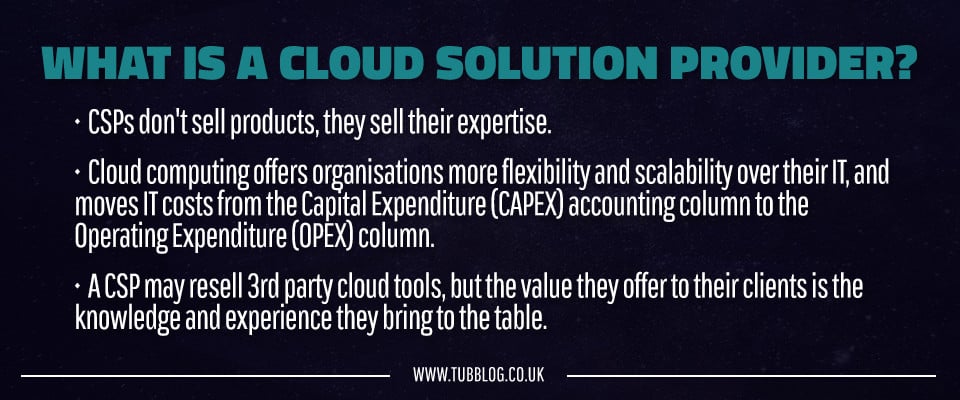










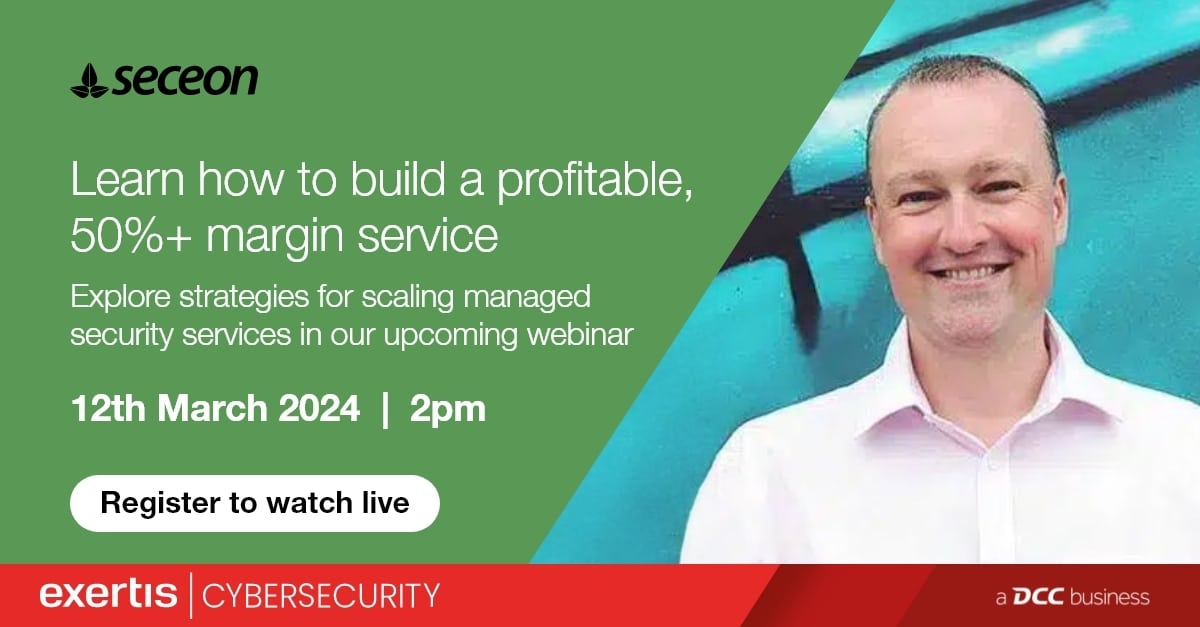



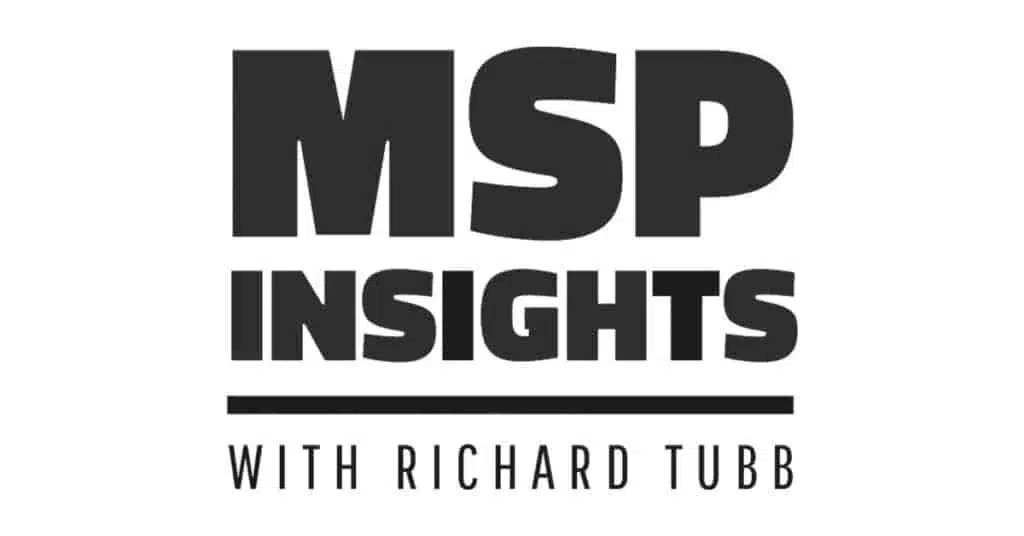
Comments